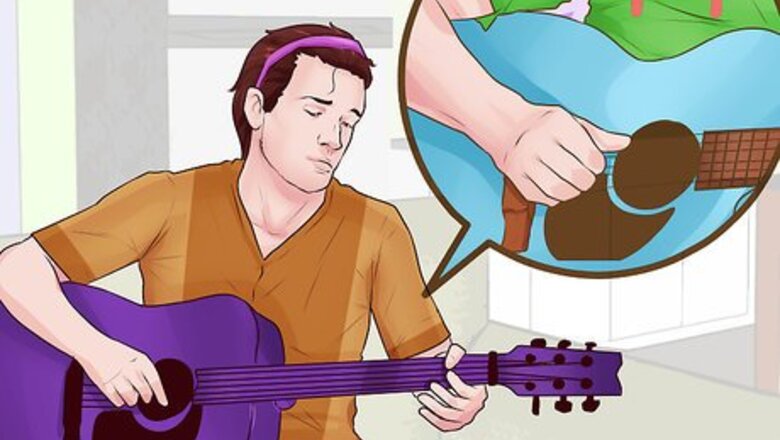
views
Learning the Strum Pattern of Reggae Guitar
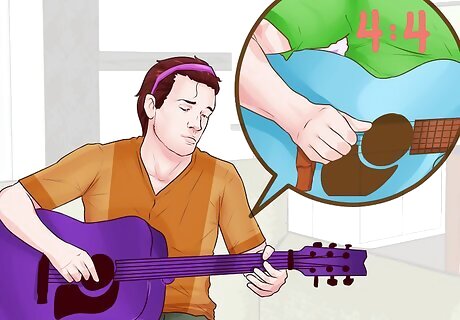
Play the chords of your reggae song on the off beats. In reggae, the strumming is generally on the offbeat. The offbeat is on the "and" that occurs in between the beats of a 4:4 time signature song. So if you're counting the beats "1... 2... 3... 4," imagine an "and" in between each main beat. This is the offbeat. A simple reggae strum pattern uses a down-strum on the "and" like "1 (and) 2 (and) 3 (and) 4 (and) 1..." Your first strum should be a down-strum. There are some exceptions to the "play on the offbeat" rule. Music is largely about conveying a sense of feeling or getting into a groove. The strumming of the strings is referred to by many different names in reggae. Some call it a "chop," "skank," or "bang."
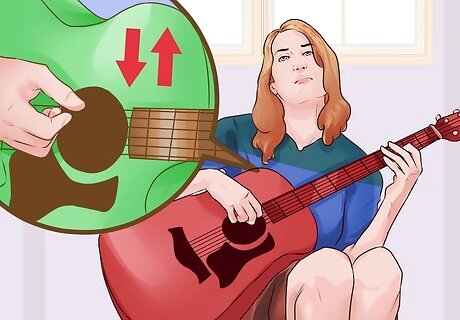
Use a down-up stroke on the offbeat. This is the second most common strum pattern in reggae music. Once you down-strum on the offbeat, draw your hand back across the strings upwards in an up-strum. Once you are more experienced with reggae, you may be able to alternate between playing down-strums and down-up strums, but while learning it may be easiest to stick with one at a time. Another common strum pattern is to single strum on the first offbeat and then do a down-up strum on the second offbeat.
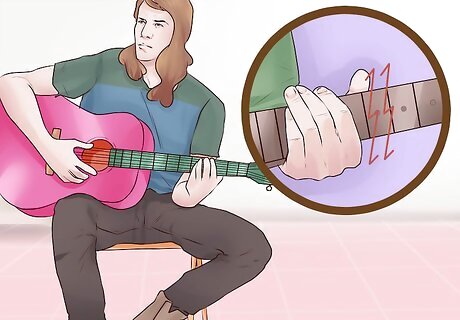
Mute the strings and practice strumming. Use firm pressure with your left hand on the fretboard to lessen the sound produced in the strings while strumming. This will create a quality of sound that's called "chicken scratch" in funk music. By muting the strings and focusing on the strum pattern, it's likely you'll pick up the groove of reggae music more quickly.

Strum along with a song. Pick one of your favorite reggae songs and listen to it to get a feel for the rhythm. Then play the song a second time, only this time strum in time with the chords that are played in the recording. Don't worry if you don't know the chords that are being played. This exercise is just to help you get a feel for the rhythm. Again, you may find it easiest to strum along with the song you have chosen by muting the strings with firm pressure in your left hand across the fretboard. This way, you won't be distracted by the sound and can focus on matching the rhythm.
Moderating Your Fret Pressure for the Reggae Sound
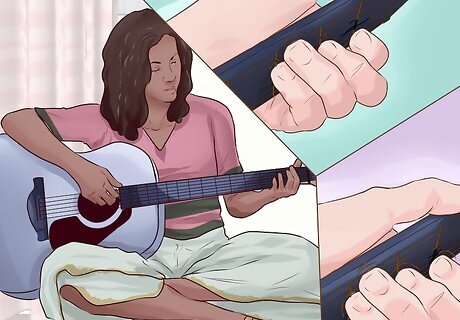
Adjust the pressure while strumming. Now that you've gotten the hang of the basic strum patters reggae, you can start working on getting the right sound out of your strings. This requires the right amount of pressure on the strings on the fretboard with your left hand. To get a feel for the effect your left hand pressure has on the sound of your guitar, play chords in reggae rhythm and adjust the pressure in your left hand as you play. Try playing chords with while using extremely light pressure, moderate pressure, heavy pressure with your left hand on the strings. Your left hand affects the sound of the strum of your chords not just by pressure on the strings but also duration. While using different levels of pressure, experiment with pressure duration. For example, you might use moderate pressure at the onset followed by the release of your left hand.
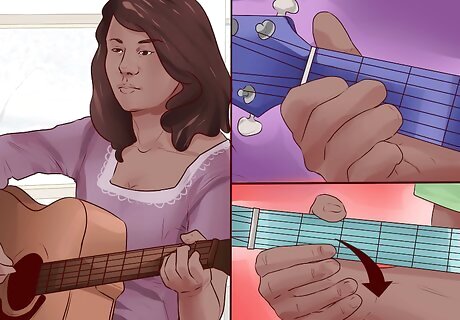
Make your notes staccato. Staccato is a musical term that means notes are played in a clipped, detached fashion from other notes. This quality can be produced by applying quick pressure to the strings with your left hand followed immediately by a sudden release.
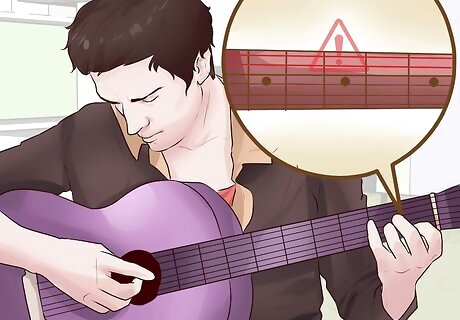
Mute the stuck line when playing in an ensemble. In reggae, the stuck line is the guitar part that follows along with the bass guitar. This part is generally muted to give a mellow tone to the acoustic accompaniment of the bass. Use moderate pressure with your left hand on your fretboard when playing the stuck line. Finger pick the notes of the stuck line to create a distinct sound in the notes.
Playing Reggae Guitar
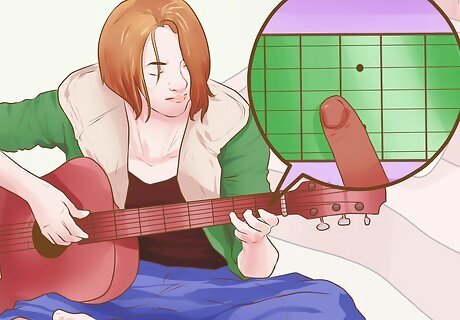
Strum in a harmonic, percussive fashion. Try to do this especially with bar chords that extend across the entire fret, like A major. Bar chords are where your finger covers the entire fret. Keep your playing arm loose and swing it down to strum your hand over all strings, from the first to the last. Many times, beginning guitarists will approach the strings on an angle with their right hand. This kind of technique can lead to missed strings in the strum. You can play reggae with a three or four string strum, but using all five is recommended. This will give you a fuller sound in your playing. The rhythm of the music is more important than hitting all the strings. As the rhythm becomes easier, you can shift your focus to hitting all the strings.
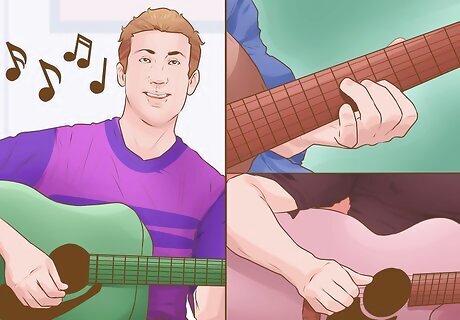
Groove with the rhythm of the music. If you play your guitar stiffly, you'll probably notice the sound of your guitar reflect this, causing your guitar to sound too mechanical and stiff for reggae. Try to get into the groove of the music by swaying gently or bobbing along with the rhythm. Your guitar should bounce slightly with your left hand as you push the sound out by drawing your right hand across the strings.
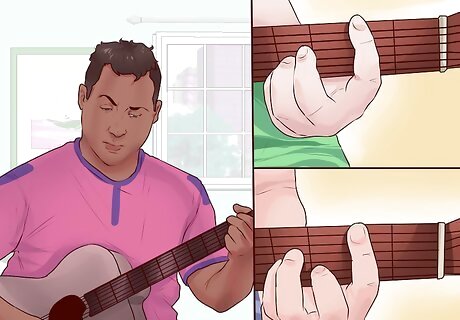
Alternate your chords. You can use both major and minor chords as you practice. You should choose chords and chord progressions that fit with the song you are trying to play. For example, you might try a 3-chord progression of the main chords of the song you are practicing. At first, look through the music and pick chords that come easy to you and sound the best together. Then try linking these with more difficult chords. Take your time connecting the chords together slowly and fluidly. This is a good opportunity for you to practice and learn the song inside and out. Once you are more comfortable, choose more complex chords and variations to put your own flavor on the sound.

Imitate the reggae masters. Some well known reggae musicians you might want to listen to include Bob Marley and the Wailers, Prince Buster, and Jackie Mittoo. Note how these performers play their songs and try to emulate it. You can look up the chords or the tabs for many of the songs played by professional musicians online. This way you don't have to guess at which chord is being played.










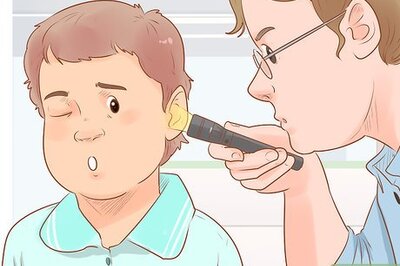






Comments
0 comment